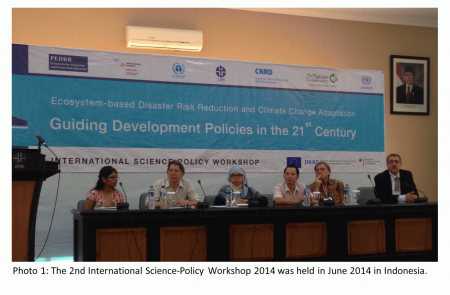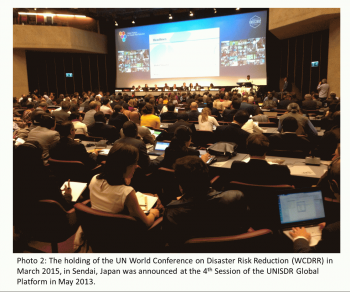04/07/2014
International Trends on Ecosystem-based Disaster Risk Reduction (Eco-DRR) - Naoya Furuta
Recently, large-scale natural disasters such as hurricanes, floods and droughts have been frequently occurring, and the increasing occurrence of these events is also underpinned by statistical data. The number of natural disasters occurring worldwide has increased over past decades. Especially, meteorological, hydrological and climatological disasters have been on the rise. In the meantime, the number of deaths due to these natural disasters shows a declining trend. It is considered that these trends signify the improvement of knowledge about and preparedness for natural disasters. On the other hand, the economic damage shows an exponentially increasing trend. Also, the occurrence data of natural disasters per region shows that the numbers of disasters, deaths and the economic losses are largely predominant in Asia.
A disaster is defined by the United Nations International Strategy for Disaster Reduction (UNISDR) as “A serious disruption of the functioning of a community or a society involving widespread human, material, economic or environmental losses and impacts, which exceeds the ability of the affected community or society to cope using its own resources.” Also, disaster risk is considered to consist of three independent elements, namely hazards (hazardous events), exposures and vulnerabilities. “Hazards” means natural phenomena including volcanic eruptions or avalanches. If such a hazard occurs in a remote place far from any town, this won’t cause a disaster. A hazard becomes a disaster only when an asset and human exists in a place where a hazard occurs (exposure), and also the asset and human is not durable against the hazard (vulnerability).
UNISDR Terminology http://www.unisdr.org/files/7817_UNISDRTerminologyEnglish.pdf
According to a trend analysis of the respective elements, hazards occur almost constantly and periodically except events such as heat waves and concentrated heavy rain under the great influence of global warming. On the other hand, vulnerability to the disasters such as capacity for coping with disasters, improvement of architectural standards and increase of economic affluence is on a recovering trend. The problem is the concentration of humans and assets in areas where hazards occur. This element of exposure is caused by population increase and urbanization on a global scale, and it is also pointed out as a crucial factor in the global increase of natural disasters.
Formerly, armies and relief agencies including humanitarian NGOs were engaged in restoration and reconstruction after disasters. However, once natural disasters were recognized as a crucial disincentive factor causing economic damage to sustainable development, UNISDR was established in 2000, and development assistance agencies such as the World Bank have shown their interest in the field of natural disasters. Now the focus is on taking measures before disasters, rather than on dealing with the problems after disasters occur.
The Hyogo Framework for Action (HFA) adopted at the World Conference on Disaster Reduction in 2005, in Kobe, Japan, was a groundbreaking outcome which has determined this direction. The HFA is the world’s first framework placing disaster risk reduction (DRR) at the core of the concept, and is a guideline for the relevant worldwide stakeholders. Disaster Risk Reduction is based on the idea of how the disasters occurring from hazards could be minimized, on the assumption that hazards occur regularly.
The HFA consisting of 5 elements is a comprehensive framework. Progress in these 5 elements has been reported to the UNISDR, and it has been found that progress in the fourth element “addressing underlying risks” is the most stagnant. In fact, ecosystem management is integrated into the fourth element “addressing underlying risks” It is obvious that sound management of ecosystems and biodiversity assists the reduction of disaster risk. Healthy forests prevent hazardous events such as landslides. Also, healthy ecosystems mitigate vulnerability: it can temporarily provide water and fuels in response to urgent demands just after disasters. Land use management through designating hazardous places as protected areas also makes a contribution to the reduction of exposure.
In addition, ecosystem-based DDR measures are often cost-effective compared to the use of artifacts like concrete, and have merit in providing adherent benefits in case there is no hazard. Accordingly, a number of ecosystem-based DRR activities have been conducted all over the world. Of course, it is difficult to prevent all disasters only by ecosystem-based measures. But, ecosystems are often effective in combination with engineering solutions or other soft measures. Nevertheless, such roles of ecosystems tend to be ignored.
In 2008, the Partnership for Environment and Disaster Risk Reduction (PEDRR) was established by more than 10 international institutions and NGOs including the International Union for Conservation of Nature (IUCN). PEDRR integrates worldwide knowledge in order to focus on the positive roles of ecosystems and biodiversity in DRR, provides training courses, and makes policy recommendations. Recently, the 2nd International Science-Policy Workshop 2014 was held in Indonesia. Some 100 researchers, policy makers and practitioners participated in this workshop and shared experiences (Photo 1).
At the same time, discussions about the relationship between natural disasters and climate change have been activated internationally. Meteorological, hydrological and climatological disasters have increased in the past, and the recently published IPCC 5th Assessment Report on Climate Change (AR5) also expects that these disasters will increase due to the influence of climate change. Accordingly, arguments about integrated approaches to Disaster Risk Reduction and Climate Change Adaptation (CCA) are growing more than ever. Actually, most parts of DRR and CCA show considerable overlap , while DRR is a short-term issue, and CCA is a long-term issue. However, when considering practical measures, these two issues should not be considered separately as one measure often contributes to both issues.
The UN World Conference on Disaster Risk Reduction (WCDRR) will be held in March 2015, in Sendai, Japan (Photo 2). Japan has played a world leading role in the field of disaster prevention hosting these conferences from the first time in Yokohama, through the second time in Kobe and to the third time in Sendai. In the 3rd Conference in Sendai, the Hyogo Framework for Action 2 (HFA2), the post HFA, will be adopted. Based on the experiences of the Great East Japan Earthquake, IUCN deepened worldwide discussion about ecosystems and biodiversity, DRR and CCA at the 1st Asia Parks Congress in November 2013 co-hosted by the Japan’s Ministry of the Environment and the IUCN. These discussions will be further deepened at the IUCN World Parks Congress to be held in Sydney, Australia in November 2014. We hope we will be able to reflect the fruitful results of these discussions at the 3rd UN WCDRR in March 2015.
(Naoya Furuta, Senior Project Officer, IUCN Japan Project Office)












